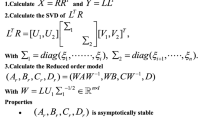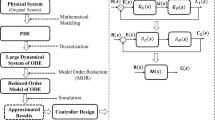Abstract
In this article, a new model order reduction scheme is proposed for the simplification of large-scale linear dynamical models. The proposed technique is based on the balanced realization method, in which the steady-state gain problem of the balanced truncation is circumvented. In this method, the denominator coefficients of the reduced system are evaluated by using the balanced realization, and the numerator coefficients are obtained by using a simple mathematical procedure as given in the literature. The proposed technique has been illustrated through some standard large-scale systems. This method gives the least performance error indices compared to some other existing system reduction methods. The time response of the approximated system, evaluated by the proposed method, is also shown which is the excellent matching of the response of the actual model when compared to the responses of other existing techniques.



Similar content being viewed by others
References
M. Belhocine, M. Belhocine, A mix balanced-modal truncations for power systems model reduction, in 2014 European Control Conference (ECC) (Strasbourg, 2014), pp. 2721–2726
D. Casagrande, W. Krajewski, U. Viaro, On the asymptotic accuracy of reduced-order models. Int. J. Control Autom. Syst. 15(5), 2436–2442 (2017)
C.F. Chen, L.S. Shieh, A novel approach to linear model simplification. Int. J. Control 8(6), 561–570 (1968)
T.C. Chen, C.Y. Chang, K.W. Han, Reduction of transfer functions by the stability-equation method. J. Frankl. Inst. 308(4), 389–404 (1979)
T.C. Chen, C.Y. Chang, K.W. Han, Model reduction using the stability-equation method and the Padé approximation method. J. Frankl. Inst. 309(6), 473–490 (1980)
B. Datta, Numerical Methods for Linear Control Systems, 1st edn. (Elsevier, Amsterdam, 2003)
M.F. Far, F. Martin, A. Belahcen, L. Montier, T. Henneron, Orthogonal interpolation method for order reduction of a synchronous machine model. IEEE Trans. Magn. 54(2), 1–6 (2018)
K.V. Fernando, H. Nicholson, Singular perturbation model reduction in frequency domain. IEEE Trans. Autom. Control 27(4), 969–970 (1984)
Z. Gajic, M. Lelic, Improvement of system order reduction via balancing using the method of singular perturbations. Automatica 37, 1859–1865 (2001)
S. Ghosh, N. Senroy, Balanced truncation approach to power system model order reduction. Electr. Power Compon. Syst. 41(8), 747–764 (2013)
K. Glover, All optimal Hankel-norm approximations of linear multivariable systems and their L, ∞-error bounds. Int. J. Control 39(6), 1115–1193 (1984)
S. Gugercin, A.C. Antoulas, A survey of model reduction by balanced truncation and some new results. Int. J. Control 77(8), 748–766 (2004)
P. Gutman, C. Mannerfelt, P. Molander, Contributions to the model reduction problem. IEEE Trans. Autom. Control 27(2), 454–455 (1982)
M.R. Hasan, L. Montier, T. Henneron, R.V. Sabariego, Matrix interpolation-based reduced-order modeling of a levitation device with eddy current effects. IEEE Trans. Magn. 54(6), 1–7 (2018)
D. Huang, H.A. Khalik, C. Rabiti, F. Gleicher, Dimensionality reducibility for multi-physics reduced order modeling. Ann. Nuclear Energy 110, 526–540 (2017)
M.F. Hutton, B. Friedland, Routh approximations for reducing order of linear, time-invariant systems. IEEE Trans. Autom. Control 20(3), 329–337 (1975)
E. Jarlebring, T. Damm, W. Michiels, Model reduction of time-delay systems using position balancing and delay Lyapunov equations. Math. Control Signals Syst. 25, 147–166 (2013)
Y.L. Jiang, C.Y. Chen, P. Yang, Balanced truncation with ε-embedding for coupled dynamical systems. IET Circuits Devices Syst. 12(3), 271–279 (2018)
T. Johnson, T. Bartol, T. Sejnowski, E. Mjolsness, Model reduction for stochastic CaMKII reaction kinetics in synapses by graph-constrained correlation dynamics. Phys. Biol. 12(4), 1–16 (2015)
R. Komarasamy, N. Albhonso, G. Gurusamy, Order reduction of linear systems with an improved pole clustering. J. Vib. Control 18(12), 1876–1885 (2011)
V. Krishnamurthy, V. Seshadri, Model reduction using the Routh stability criterion. IEEE Trans. Autom. Control 23(3), 729–731 (1978)
D.K. Kumar, S.K. Nagar, J.P. Tiwari, A new algorithm for model order reduction of interval systems. Bonfring Int. J. Data Min. 3(1), 6–11 (2013)
B.C. Kuo, Automatic Control Systems, 7th edn. (Prentice-Hall, Upper Saddle River, 1995)
P. Kurschner, Balanced truncation model order reduction in limited time intervals for large systems. Adv. Comput. Math. (2018). https://doi.org/10.1007/s10444-018-9608-6
G. Langholz, D. Feinmesser, Model order reduction by Routh approximations. Int. J. Syst. Sci. 9(5), 493–496 (1978)
T.N. Lucas, Factor division: a useful algorithm in model reduction. IEE Proc. D Control Theory Appl. 130(6), 362–364 (1983)
S.S. Mohseni, M.J. Yazdanpanah, A.R. Noei, Model order reduction of nonlinear models based on decoupled multimodel via trajectory piecewise linearization. Int. J. Control Autom. Syst. 15(5), 2088–2098 (2017)
B.C. Moore, Principal component analysis in control system: controllability, observability, and model reduction. IEEE Trans. Autom. Control 26(1), 17–36 (1981)
A. Narwal, R. Prasad, A novel order reduction approach for LTI systems using cuckoo search optimization and stability equation. IETE J. Res. 62(2), 154–163 (2016)
S.V. Ophem, A.V.D. Walle, E. Deckers, W. Desmet, Efficient vibro-acoustic identification of boundary conditions by low-rank parametric model order reduction. Mech. Syst. Signal Process. 111, 23–35 (2018)
J. Pal, Stable reduced-order Padé approximants using the Routh–Hurwitz array. Electron. Lett. 15(8), 225–226 (1979)
L. Pernebo, L.M. Silverman, Model reduction via balanced state space representations. IEEE Trans. Autom. Control 27(2), 382–387 (1982)
A. Pierquin, T. Henneron, S. Clénet, Data-driven model-order reduction for magnetostatic problem coupled with circuit equation. IEEE Trans. Magn. 54(3), 1–4 (2018)
A.K. Prajapati, R. Prasad, Padé approximation and its failure in reduced order modelling, in 1st International Conference on Recent Innovations in Electrical, Electronic and Communications Systems. (RIEECS-2017) (Dehradun, 2017)
A.K. Prajapati, R. Prasad, Failure of Padé approximation and time moment matching techniques in reduced order modelling, in IEEE 3rd International Conference for Convergence in Technology (I2CT-2018) (Pune, 2018)
A.K. Prajapati, R. Prasad, Order reduction of linear dynamic systems with an improved Routh stability method, in IEEE International Conference on Control, Power Communication and Computing Technologies (ICCPCCT-2018) (Kerala, 2018)
A.K. Prajapati, R. Prasad, Model order reduction by using the balanced truncation method and the factor division algorithm. IETE J. Res. (2018). https://doi.org/10.1080/03772063.2018.1464971
A.K. Prajapati, R. Prasad, Order reduction of linear dynamic systems by improved Routh approximation method. IETE J. Res. (2018). https://doi.org/10.1080/03772063.2018.1452645
A.K. Prajapati, R. Prasad, Reduced order modelling of LTI systems by using Routh approximation and factor division methods. Circuits Syst. Signal Process. (2018). https://doi.org/10.1007/s00034-018-1010-6
A.K. Prajapati, R. Prasad, Reduced order modelling of linear time invariant systems using factor division method to allow retention of dominant modes. IETE Tech. Rev. (2018). https://doi.org/10.1080/02564602.2018.1503567
A.K. Prajapati, R. Prasad, Reduced order modelling of linear time invariant systems by using improved modal method. Int. J. Pure Appl. Math. 119(12), 13011–13023 (2018)
R. Prasad, Padé type model order reduction for multivariable systems using Routh approximation. Comput. Electr. Eng. 26(6), 445–459 (2000)
J. Qi, J. Wang, H. Liu, A.D. Dimitrovski, Nonlinear model reduction in power systems by balancing of empirical controllability and observability covariances. IEEE Trans. Power Syst. 32(1), 114–126 (2017)
D. Qian, S. Tong, X. Liu, Load frequency control for micro hydro power plants by sliding mode and model order reduction. Autom. J. Control Meas. Electron. Comput. Commun. 56(3), 318–330 (2015)
Y. Shamash, Stable reduced-order models using Padé-type approximations. IEEE Trans. Autom. Control 19(5), 615–616 (1974)
Y. Shamash, Linear system reduction using Padé approximation to allow retention of dominant modes. Int. J. Control 21(2), 257–272 (1975)
Y. Shamash, Truncation method of reduction: a viable alternative. Electron. Lett. 17(2), 97–98 (1981)
Z. Shi, W.O. Brien, Building energy model reduction using model-cluster-reduce pipeline. J. Build. Perform. Simul. (2017). https://doi.org/10.1080/19401493.2017.1410572
A. Sikander, R. Prasad, Linear time-invariant system reduction using a mixed methods approach. Appl. Math. Model. 39(15–16), 4848–4858 (2015)
A. Sikander, R. Prasad, Soft computing approach for model order reduction of linear time invariant systems. Circuits Syst. Signal Process. 34(11), 3471–3487 (2015)
A. Sikander, R. Prasad, A new technique for reduced-order modelling of linear time-invariant system. IETE J. Res. 63(3), 316–324 (2017)
V. Singh, Nonuniqueness of model reduction using the Routh approach. IEEE Trans. Autom. Control 24(4), 650–651 (1979)
N. Singh, R. Prasad, H.O. Gupta, Reduction of linear dynamic systems using Routh–Hurwitz array and factor division method. IETE J. Educ. 47(1), 25–29 (2006)
J. Singh, C.B. Vishwakarma, K. Chatterjee, Biased reduction method by combining improved modified pole clustering and improved Padé approximations. Appl. Math. Model. 40, 1418–1426 (2016)
A.K. Sinha, J. Pal, Simulation based reduced order modelling using a clustering technique. Comput. Electr. Eng. 16(3), 159–169 (1990)
A. Sootla, J. Anderson, On projection-based model reduction of biochemical networks part II: the stochastic case, in Proceedings of the 53rd IEEE Conference on Decision and Control (Los Angeles, 2014), pp. 3621–3626
F.A. Taie, H. Werner, Balanced truncation for temporal- and spatial-LPV interconnected systems based on the full block S-procedure. Int. J. Control (2018). https://doi.org/10.1080/00207179.2018.1440087
C.B. Vishwakarma, Order reduction using modified pole clustering and Padé approximations. Int. J. Electr. Comput. Energ. Electron. Commun. Eng. 5(8), 998–1002 (2011)
C.B. Vishwakarma, R. Prasad, Clustering method for reducing order of linear system using Padé approximation. IETE J. Res. 54(5), 326–330 (2008)
Q. Wang, Y. Wang, E.Y. Lam, N. Wong, Model order reduction for neutral systems by moment matching. Circuits Syst. Signal Process. 32, 1039–1063 (2013)
H. Zhang, L.W.P. Shi, Y. Zhao, Balanced truncation approach to model reduction of Markovian jump time-varying delay systems. J. Frankl. Inst. 352, 4205–4224 (2015)
Author information
Authors and Affiliations
Corresponding author
Additional information
Publisher’s Note
Springer Nature remains neutral with regard to jurisdictional claims in published maps and institutional affiliations.
Rights and permissions
About this article
Cite this article
Prajapati, A.K., Prasad, R. Order Reduction in Linear Dynamical Systems by Using Improved Balanced Realization Technique. Circuits Syst Signal Process 38, 5289–5303 (2019). https://doi.org/10.1007/s00034-019-01109-x
Received:
Revised:
Accepted:
Published:
Issue Date:
DOI: https://doi.org/10.1007/s00034-019-01109-x




